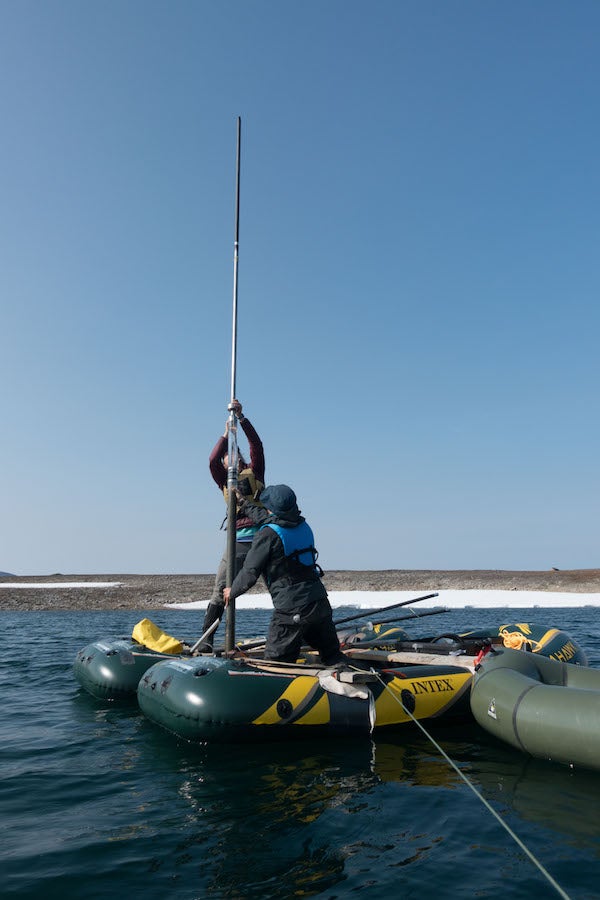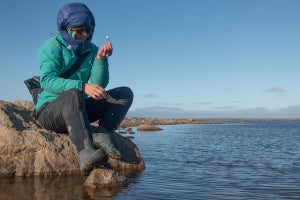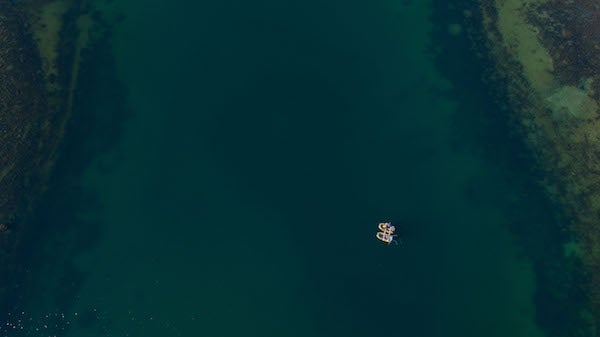This article was published in Scientific American’s former blog network and reflects the views of the author, not necessarily those of Scientific American
Standing at the shore of a cold and remote lake in the Canadian Arctic, I suddenly wished I had spent more than $60 on the inflatable rafts I ordered from Amazon. I bought them for their compactness while contemplating flying north with 10 checked bags packed with research equipment, but set against this stark and expansive landscape, they looked tiny—and precarious.
Our two rafts, attached with a makeshift frame of scavenged scrap wood, served as the humble research vessel from which we planned to collect lake sediments on Baffin Island, a rugged land mass just west of Greenland. We gingerly pushed off the rocks, weighed down by unwieldy research equipment, venturing into waters hovering just above freezing.
My field partner Greg de Wet and I held our breath. There was a leak in the bottom of one of the rafts, but we had deemed it “workable enough” after our feeble patching attempt failed. “Workable enough” was our gold standard, as the nearest hardware store was nearly 500 miles away, with no road to get there anyway. As we paddled out across the glassy surface, we slowly gained confidence in our rig and began to fully appreciate the spectacular backdrop of rolling green tundra and distant glacier-draped peaks.
On supporting science journalism
If you're enjoying this article, consider supporting our award-winning journalism by subscribing. By purchasing a subscription you are helping to ensure the future of impactful stories about the discoveries and ideas shaping our world today.
We were on Baffin Island to study how climate change has affected the Arctic tundra over the last 10,000 years. While the whole Earth is currently warming inexorably, Arctic temperatures are skyrocketing. The Arctic is expected to warm about twice as much as the rest of the planet by the end of this century. This comes as no surprise to paleoclimatologists, who study climate change through Earth’s history; temperature swings in the Arctic have always been much more dramatic than those at lower latitudes. We can peer into the past to learn about how Arctic ecosystems have responded to past warming in order to predict what will happen as the Arctic warms rapidly now and in the future.

The scientists take sediment cores from the lake bottom. Credit: Zach Montes Orijin Media
And in August, after flying on progressively smaller planes from Denver to D.C. to Ottawa to Iqaluit to the tiny Inuit community of Clyde River, followed by a harrowing six-hour off-road ATV journey, Greg and I were ready to peer into the past through the clear waters of a small, unassuming lake.
Baffin Island: 2017 Field Season from Orijin Media on Vimeo
Our target was the mud at the bottom of the lake. The sediment that accumulates on a lake bottom serves as an archive of past environmental change, indirectly documenting changes in temperature and ecology continuously over thousands of years. Paleoclimatologists have spent decades honing the analytical tools we use to read and interpret such archives, and methods continue to evolve. My approach is a relatively new one: extracting ancient plant DNA from the mud in order to reconstruct a series of time-stamped snapshots of the plant communities that lived around the lake through time. The frigid Arctic waters act as a refrigerator, keeping DNA preserved for tens of thousands of years. If the water were warmer, the DNA would degrade much more quickly.
We camped at the site for five days, ironing out the kinks in our coring system, exploring various locations, and waiting out an unexpected mid-summer snowstorm. Ultimately, we collected three full sediment cores, each about five feet in length and enclosed in a rigid plastic tube. Our success in sample collection was encouraging, but the fact that our boats held up long enough to keep us from plunging into the water was more immediately exciting.
We moved on to the next lake with newfound confidence that our strategy was working. Our team, made up of me and Greg, local Inuk guide Lasalie Joanasie, and photographer Zach Montes, once again loaded up the ATVs beyond capacity and set out across the tundra, stopping to fix a flat tire at least a dozen times and getting stuck multiple times in the middle of an icy river crossing. Our next coring site was lower in elevation and very near to the coast; our hope was that the difference in climate between the sites would allow us to compare ancient plant communities in contrasting settings. But a site nearer to the coast meant an additional challenge: we were working on a veritable polar bear thoroughfare.
We had only been on the lake for a couple of hours when Lasalie, our dedicated polar bear watchman, shouted, “Three big bears, heading this way!” Our priorities immediately shifted from science to survival. We paddled anxiously to shore, making sure to secure our boats and precious samples safely on the rocks, and hurried up the hill above camp with binoculars and loaded shotgun in hand. (If someone had told me that my PhD would involve learning how to safely handle a firearm, I would have laughed.) Adrenaline pulsed through my body as we watched a formidable trio of bears wander in our direction from a few hundred yards away, seemingly unaware of us thanks to our downwind position. Watching these enormous creatures move gracefully across the landscape took our breath away.

The author on the shore of a "small, unassuming lake." Credit: Zach Montes Orijin Media
Fortunately for all parties involved, we discovered that a surprisingly effective bear deterrent came not in the form of a gun, but in the shrill whirr of a small drone. Zach had joined the research team to document our fieldwork, equipped with a drone for capturing aerial footage. After weighing the risks involved—what if the drone alerted the bears to our presence?—he cautiously flew it in the direction of the bears, aiming to capture some opportunistic footage of the magnificent animals. But as soon as they heard the drone’s unfamiliar high-pitched whine, the bears turned and hurtled toward the coast, never slowing as they disappeared over the horizon.
Our fieldwork took on a new sense of urgency after this encounter. Aided by the near-24 hours of light, we worked late into the cold, dusky night. We paused only for food and slept very little, knowing that the thin nylon of our tent would do little to protect us from a bear attack. (Lasalie was on watch through most of the night, but the possibility of a bear making its way into camp still was on our minds.)
By late the next morning, we were heading back to town with two pristine sediment cores in hand. With some strategic corner-cutting, fear-driven focus and a bit of good luck, we had completed in 24 hours a task we had originally expected to take four days. And already, we could see that we had something good: the bottoms of our cores were chock-full of ancient moss, probably 10,000 years old, hinting that the sediment would indeed provide a detailed record of past vegetation and that the countless hours I’d spend in the lab processing these samples might be fruitful.
As we boarded our first plane home, I marveled at all that had gone into collecting a few tubes of mud—many months of planning and immeasurable manual labor, treacherous backcountry travel and, of course, a lot of money. I was so nervous for the safety of our precious cores that I briefly considered buying them their own seat on the plane. My $60 boats taught me the lesson of being penny-wise and pound-foolish, although in the end, they held together. And, in the end, the cores survived, too.
Now, the real science adventure begins: the many months of analyzing the microscopic information contained within that mud, to unravel the story of climate and ecological change over the last 10,000 years.

Credit: Zach Montes Orijin Media